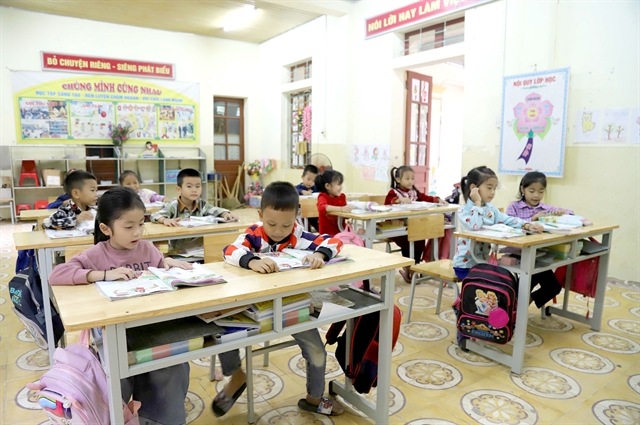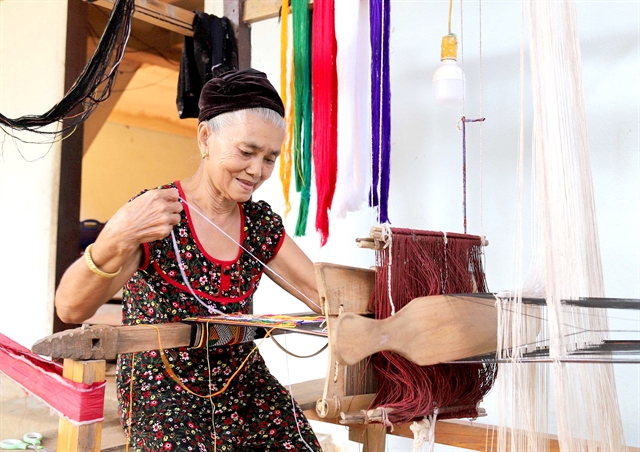 Society
Society

 |
| First grade students in a classroom at Nga My Elementary School, Văng Môn Village. — VNA/VNS Photos |
NGHỆ AN — The Ơ Đu ethnic minority in Nghệ An Province's Văng Môn resettlement village has seen progress in their lives over the past 17 years, during which they gave up their land for the construction of the Bản Vẽ hydroelectric project in Tương Dương District.
Among Việt Nam's 54 ethnic communities, the Ơ Đu people are one of the five smallest ethnic groups, along with the Si La, Pu Péo, Brâu and Rơ Măm people.
The Ơ Đu are now the sole representatives of their ethnic group in Nghệ An Province.
Previously, they inhabited two villages, Xốp Pột and Kim Hòa, in Kim Đa Commune, Tương Dương District, along with some scattered households in Kim Tiến and Xá Lượng communes, Vietnamplus.vn reported.
In 2006, the Ơ Đu community made the move to the Văng Môn resettlement village, located approximately 70km away from the Tương Dương District centre along National Highway 48C, in Nga My Commune. This move was made to facilitate the construction of the Bản Vẽ hydroelectric plant.
A few Ơ Đu families chose to reside alongside people from the Thái and Khơ Mú ethnic groups in four communes of Tam Đình, Thạch Giám, Xá Lượng, and Lượng Minh, all within the Tương Dương District.
Vi Thị Mùi, vice chairwoman of the People's Committee in Nga My Commune, said that the Ơ Đu community in Văng Môm now consists of 102 households with a total population of 345 people.
After 17 years in their new settlement, they have experienced significant improvements in both material and spiritual well-being. The most remarkable change is their increased focus on agricultural and livestock development, and concerning the education of their children.
The preservation of customs, traditions and cultural identity remains a top priority.
They have set up a cultural performance group and a club dedicated to fostering happy families. The age-old tradition of brocade weaving is still passionately practised by the local women. Various rituals and festivals, folk dances, traditional cuisine and bamboo-woven products are still revered and carefully upheld.
All Ơ Đu households now enjoy access to electricity for lighting and clean water, and are provided health insurance cards.
Authorities at all levels are diligent in executing policies and support initiatives, including tree planting, livestock breeding, electricity subsidies and economic development loans, to benefit the Ơ Đu community.
One of the most notable improvements in the Văng Môn village is the well-maintained internal road system, which has been upgraded with concrete paving. The presence of National Highway 48C passing through the village has provided a significant advantage for the people of Văng Môn to engage in business, trade goods, and reshape their economy.
The vice chairwoman also highlighted the substantial impact of various government programmes and projects supporting the positive transformation of the Ơ Đu people.
These initiatives include decisions on providing land, agricultural resources and clean water to poor ethnic minorities in extremely difficult communes and villages.
Additionally, the resettlement support policy and the new rural development and sustainable poverty reduction programme have played a vital role in this transformation.
Two Government decisions of particular significance are those on promoting socio-economic development within extremely small ethnic minority groups, and the cultural development target programme for the 2016-2020 period.
In 2017, the project to support the socio-economic development of Ơ Đu Ethnic Group for the period 2016-2025, executed by Nghệ An Province, brought investments to the Ơ Đu community. These included the drilling of wells, the development of traditional weaving, the construction of numerous cattle pens with over 300 breeding cows, grass-cutting machines, land cultivation and grass seeds, and the initiation of Ơ Đu language classes.
Cultural preservation
 |
| Vi Thị Dung, 76 years old, is one of the very few people who still retain the knowledge and skills to weave traditional Ơ Đu costumes. |
The vice chairwoman said that Nga My Commune has nine villages with a population of over 1,110 people, belonging to four ethnic groups of Thai, Kinh, Ơ Đu and Khơ Mú. Among them, the Thai ethnic group accounts for 90 per cent. The process of cohabitation among these ethnic groups has led to influence, interaction, and a blending of lifestyles, customs, traditions and cultures within the Ơ Đu community.
Although the Ơ Đu people still preserve their unique characteristics, such as traditional activities and rituals during festivals and New Year celebrations, their culture is still at risk of being lost.
Their traditional clothing is now only seen during special occasions and festivals. Usually, they wear clothing styles influenced by the Thai, Khơ Mú, and Kinh ethnic groups.
Additionally, their traditional housing has also transitioned to a more modern style, resembling resettlement houses or Thai-style stilt houses.
What raises significant concern is the gradual fading of their traditional attire, language and cultural practices, Mùi said.
Vi Thị Dung, 76, is one of the very few people who still retains the knowledge and skills required to weave and craft traditional Ơ Đu attire.
Dung said fashioning the Ơ Đu traditional clothing is a complex process, involving many steps that necessitate the search for raw materials.
"There were once many skilled weavers who eventually moved away from the craft, while the younger generation has shown little interest in it."
Since 2007, following their relocation to the resettlement village and concerns about the potential decline of their ethnic group's traditional clothing, she took it upon herself to revive the weaving.
However, due to her age, crafting an entire Ơ Đu outfit now requires about two weeks.
The preservation of Ô Đu ethnic culture faces a pressing issue regarding the recovery of their language and script.
Lo Thanh Bình, a 75-year-old resident from Văng Môn village, said: "At present, there are only a few people in Văng Môn who retain some knowledge of the Ơ Đu language and vocabulary. In the past, the Ơ Đu language was widely used. However, as the older generations passed away and the descendants started living with other ethnic groups, our language gradually disappeared."
"At present, very few villagers can speak Ơ Đu language, partly due to its challenging pronunciation and memorisation, making it likely to be forgotten. Efforts to teach Ơ Đu language in the community have yielded limited results."
"Some courses have been organised to teach Ơ Đu language to the local residents through oral tradition, but the results have not met expectations. Preserving the language is indeed a challenging task because there are very few people who know it. We are still in search of source materials and individuals who are knowledgeable about Ơ Đu writing to restore this script," said Lương Xuân Hiệp, the head of the Ethnic Affairs Department in Tương Dương District. — VNS